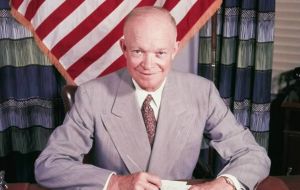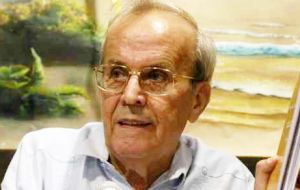MercoPress. South Atlantic News Agency
Cuba/US: catching a glimpse of the possible future
 The hostile policy first adopted by President Eisenhower (1953/61) was followed with only slight variations by Republican and Democratic administrations
The hostile policy first adopted by President Eisenhower (1953/61) was followed with only slight variations by Republican and Democratic administrations  For years it had been clear that U.S. policy aimed at isolating Cuba had been a failure, and had ended up isolating the United States, points out Alarcón
For years it had been clear that U.S. policy aimed at isolating Cuba had been a failure, and had ended up isolating the United States, points out Alarcón By Leonardo Padura Fuentes (*) - All Cubans, on either side of the Florida Straits, but also in places like Spain, France or Greenland – where there must be a couple of Cubans – as well felt it was a historic moment that included each and every one of us, when U.S. President Barack Obama announced on Dec. 17 the normalization of relations after half a century of hostility.
Admitting that the U.S. government’s anti-Cuba policy had failed, reestablishing diplomatic ties, lifting all of the restrictions within his reach, proposing the complete elimination of the embargo and launching a new era in relations with Cuba, all in one single speech, went beyond anyone’s predictions and took everyone by surprise, even the most seasoned analysts.
The hostile policy first adopted by President Dwight D. Eisenhower (1953-1961), before the current president was even born, was followed with only slight variations by Republican and Democratic administrations, and codified by the Helms-Burton Act signed into law by President Bill Clinton in 1996.
In the first few years the policy was practiced with a high degree of success. In 1959, when the Cuban revolution triumphed, the United States was at the height of its power, exercising indisputable hegemony over a large part of the world, especially the Western Hemisphere, which enabled it to get Cuba kicked out of the Organization of American States (OAS) and to achieve the near total isolation of this Caribbean island nation, which was left with only the support and aid of the Soviet Union and its partners in the Council for Mutual Economic Assistance (CMEA), which grouped the countries of the Warsaw Pact.
The collapse of real socialism gave rise to hopes among many people that the end of the Cuban revolution was also at hand.
They imagined the advent of a long period of unipolar dominance. Drunk on the victory, they failed to appreciate the deeper meaning of what had happened: the end of the Cold War opened up new possibilities for social struggles and faced capitalism with challenges that were increasingly difficult to tackle.
The fall of the Berlin Wall blinded them from seeing that a social uprising known as the “Caracazo”, which shook Venezuela at the same time, in February 1989, was a sign of the start of a new age in Latin America.
Cuba managed to survive the disappearance of its long-time allies, and its ability to do so was a key factor in the profound transformation of the region. For years it had been clear that the U.S. policy aimed at isolating Cuba had been a failure, and had ended up isolating the United States, as acknowledged by U.S. Secretary of State John Kerry.
A new relationship with Cuba was indispensable for Washington, which needed to rebuild its ties with a region that is no longer its backyard. Achieving that is fundamental now because, despite its power, the United States cannot exercise the comfortable leadership of times that will not return.
But there is still a long way to go before that new relationship can be established. First of all, it is necessary to completely eliminate the economic, trade and financial embargo, as demanded with renewed vigor by major segments of the U.S. business community.
But normalizing relations would suppose, above all, learning to live with differences and abandoning old dreams of domination. It would mean respecting the sovereign equality of states, a fundamental principle of the United Nations Charter, which, as history has shown, does not always please the powerful.
With regard to the release of the five Cuban prisoners, all U.S. presidents, without exception, have broadly used the authority granted to them by article 2, section 2, clause 1 of the U.S. constitution. For over two centuries, presidents have had the unlimited power to grant reprieves and pardons for offences against the United States.
In the case of “the Cuban Five,” there were ample reasons for executive clemency. In 2005, a three-judge panel of the U.S. Court of Appeals overturned the trial as “a perfect storm of prejudice and hostility” and ordered a new trial.
In 2009 the same court threw out the sentences against three of the Cuban Five because they had neither sought nor passed on any military secrets, nor had they endangered U.S. national security.
Both verdicts were unanimous.
With respect to another major charge, “conspiracy to commit murder,” against Gerardo Hernandez Nordelo, his accusers admitted that it was impossible to prove such an allegation, and even attempted to drop the charge in May 2001 in a move without precedent, made no less by public prosecutors under then-President George W Bush (2001-2009).
Hernandez had been waiting for five years for a response to one of his many petitions to the Miami court for release, a review of his case, an order for the government to produce the “proof” used to convict him, or for the government to reveal the magnitude and scope of official funding for the colossal media campaign that fed the “perfect storm.”
The court never responded. Nor did the mainstream media say anything about the judicial system’s unusual paralysis. It was obvious that it was a politically motivated case that could only be resolved by a political decision, which only the president could take.
Obama demonstrated wisdom and determination when, instead of simply using his authority to release the prisoners, he bravely confronted the underlying problem. The saga of the “Cuban Five” was the consequence of an aggressive strategy, and the wisest thing was to put an end to both at the same time.
No one can deny the importance of what was announced on Dec. 17. It would be a mistake, however, to ignore that there is still a ways to go, and that it will be necessary to follow that possibly long and tortuous path with resolution and insight.
(*) Ricardo Alarcón was Cuba's Permanent Representative to the United Nations (UN) for nearly 30 years and later served as Minister of Foreign Affairs from 1992 to 1993. Subsequently Alarcón was President of the National Assembly of People's Power from 1993 to 2013, and because of this post, was considered the third-most powerful figure in Cuba. He also was a Member of the Central Committee of the Communist Party of Cuba until 2013.




Top Comments
Disclaimer & comment rules-

-

-

Read all commentsCareful what you wish for. This is going to change Cuba far more than the US.
Jan 24th, 2015 - 05:03 pm 0I don't think the Castros fully appreciate that.
catching a glimpse of the possible future
Jan 24th, 2015 - 07:49 pm 0joint naval exercises
joint air force exercises
joint army exercises
Cuban troops fighting along side American troops,
a new member of nato and all the rest.
mmmmmmmmm
Amazing things, Futures...
http://en.mercopress.com/2015/01/24/cuba-us-catching-a-glimpse-of-the-possible-future#comment377221: Tell me, are you drunk? It is more likely that the US will leave NATO, that organization having reached its use by date, than Cuba joining it.
Jan 25th, 2015 - 02:59 am 0Commenting for this story is now closed.
If you have a Facebook account, become a fan and comment on our Facebook Page!